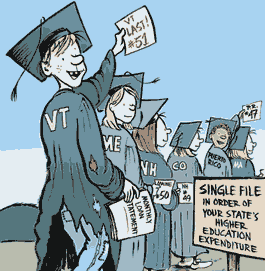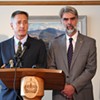Published February 13, 2002 at 4:00 a.m. | Updated April 29, 2020 at 8:38 a.m.
Vermont takes justifiable pride in its reputation for progressive social policies, despite being a lightly populated state of modest means. But in one aspect of the common weal, Vermont provides measly assistance, lagging shamelessly behind historically impoverished, even reactionary, states such as Mississippi and New Hampshire. >>
By several measurements, Vermont ranks dead last, or close to it, in public support for higher education — a financial as well as a public relations challenge to incoming University of Vermont President Dan Fogel. For example, by funding its university and colleges at the equivalent of $4.84 for every $1000 of residents’ disposable income, Vermont occupies 49th place among the states in this category. The national average is $8.58 per $1000 of disposable income — 77 percent more than what Vermont allots. Vermont finishes even further behind the pack in the percentage of total state expenditures devoted to higher education — 51st on a list that includes Puerto Rico.
These miserly outlays for the Univer-sity of Vermont and the Vermont State Colleges have caused demonstrable damage to the institutions.
UVM’s academic reputation has fallen far from the glory days of the 1980s, when the school was acclaimed as a “public Ivy.” The university now attracts packs of out-of-state students who, as their SUVs attest, are able to afford the whopping tuition rates the school charges to compensate for the scant support it gets from the Legislature. Vermonters attending UVM have big bills to pay as well; tuition for in-staters is the highest of any land-grant university in the country.
The Community College of Vermont similarly whacks in-state students with the highest tuition in the United States for such institutions. And like UVM, the five schools that comprise the state college system are having trouble attracting high-quality faculty due to the below-average salaries they offer.
Vermont didn’t stumble dumbly into last place in the higher-ed funding league, nor is its current cellar status a result, primarily, of the decades when Vermont also was among the poorest states.
The comparatively meager tax-dollar support for the state university and colleges reflects a conscious policy decision made in the early 1970s, according to a historical analysis compiled by Bruce Post, director of federal affairs at the Vermont Student Assistance Corporation.
Republican Gov. Deane Davis opted in 1971 to nearly double the appropriation for VSAC, which had been created in 1965 to help eligible Vermonters cover tuition, Post notes. Davis and one of his Republican successors, Richard Snelling, also chose to keep direct state aid to Vermont’s public colleges and university at traditional low levels. This approach became known as “the Vermont Model,” and Post, who was policy director under Snelling, is downright proud of it.
Vermont was making a commitment to social equity, Post argues, in helping lower-income Vermonters continue their education beyond high school while at the same time forcing UVM and the state colleges to impose high tuition. The “student-centered, needs-based funding” policy involving focused support for VSAC is preferable to the “institutional, needs-blind aid” that most states provide, Post argues.
“The Vermont Model has placed a greater emphasis on people than the different approaches taken in many other states, where institutional aid is high and student aid is low,” Post writes in his 1995 analysis, which he still stands by.
Other states ensure poorer students access to college through their low-tuition policies, Post acknowledges. But, he adds, “The range of options is limited only to the public schools offering subsidized low tuition. The Vermont Model, by contrast, opens up the broader educational market for students with need and gives them some of the same choices others might take for granted.” In other words, Vermont’s lower-income students can have a shot at more prestigious schools if they are accepted into them.
The high-tuition standard foisted upon UVM and the Vermont State Colleges has the further salutary effect, according to Post, of requiring them to compete intensively with schools in other states for student enrollments. What’s more, the Vermont Model has been a boon to taxpayers, Post points out. The state boasts “the lowest tax burden for higher education in the country” along with a “mixed-market, higher-education economy of enormous diversity” — that is, from prestigious private schools like Middlebury College to the community college system, which serves many nontraditional students.
But Vermont’s bottom-of-the-pile ranking in higher education funding takes full account of the appropriations the Legislature makes to VSAC. So regardless of Republican socio-economic theorizing that presents the Vermont Model as progressive, the state is providing its young people with just about the lowest overall level of public support for higher education in the entire country.
And to a certain degree, Vermont is getting what it pays for. “We have a very dedicated, hard-working group of people in the Vermont State Colleges and the university,” says Roy Vestrich, a communications professor at Castleton State College and the president of the VSC faculty federation. “But at some point the stresses do start to show. Look at the turnover in top administration positions at UVM and our own difficulty in filling faculty openings.”
David Wolk, the new president of Castleton State, agrees that underfunding of the state college system makes it hard to recruit top-flight faculty and staff. The budget shortfalls resulting from low state aid and rising enrollment necessitates that “I will spend an inordinate amount of my time raising money for the college,” Wolk adds.
The former Vermont education commissioner, Wolk quickly supplies a to-do list when asked how Castleton would spend substantially greater amounts of state aid: “We could raise pay, make improvements to the library and to the fitness center, and we could enhance the cultural opportunities available to our students on campus.”
VSC faculty did manage to gain more competitive compensation packages in the four-year contract negotiated in 1999, Vestrich notes. But professors in the Vermont state college system are still, on aggregate, paid below the national average for institutions of that type, he adds. And pay rates remain pitiable at the two-year Vermont Community College, where all faculty work in an adjunct capacity. A teacher with a full-time-equivalent course load at the Community College earns about the same as a custodian. “Is that fair?” Vestrich asks.
Wage rates for faculty at UVM are far below what’s paid at most comparable institutions, says Peter Stavrakis, a political science professor and head of the recently formed UVM faculty union. The $53,000 average salary for UVM professors of all ranks — not including those in the College of Medicine — places them far down in the bottom fifth among faculty at state universities around the country, Stavrakis says.
“A university becomes great when it has a great faculty,” observes Democratic former Gov. Madeleine Kunin. The state university does have some individually great professors, she adds, but “UVM has to do better in this regard.” And it won’t be able to, says Kunin, a scholar in residence at Middlebury College, as long as state funding falls far short of the national norm.
If the low-funding, high-tuition Vermont Model is a product of the era of Republican dominance of state politics, why has it remained intact during the past two decades of Democratic ascendancy — not to mention concomitant shifts in Vermont’s demographics? The influx of more affluent outsiders to the state has surely elevated cultural standards and expectations regarding higher education.
Kunin attributes the funding dilemma in part to the inherent difficulty of changing long-held ideas. In other words, inertia. In fact, a significant proportion of state legislators remain committed to the Vermont Model. Veteran Republican State Sen. William Doyle, for example, expresses the belief that appropriations to VSAC help offset the low level of state aid for UVM and the state colleges. It’s also a matter of priorities, Doyle says. “You can make a good case that elementary and secondary education require a tremendous amount of support. That’s where Vermont has chosen to put most of its education funding.”
Advocacy on behalf of K-12 public schools is stronger than for higher-education institutions, adds David Wolk. He notes that the total number of school board members, teachers, administrative staff and parents enables elementary and secondary education to wield considerable clout in budget battles — “much more than what higher education can muster,” Wolk says.
In addition, the state has a limited capacity to make additional resources available to its public higher education institutions, agrees former Gov. Phil Hoff. Today, as well as during his own tenure in the 1960s, about three-quarters of the state budget is locked into mandatory commitments, among them Medicaid, welfare and the salaries of state employees, Hoff notes. This creates fierce competition among a variety of interests for the 25 percent share of the total budget that could be tapped for aid increases.
Peter Stavrakis, the UVM faculty leader, also holds to the view of Vermont as a state with limited ability to hike funding for higher ed. “Vermont has made a choice to distribute resources differently than do Midwestern states,” notes Stavrakis, who attended the University of Wisconsin. In much of the heartland, he says, state universities are highly prestigious and generously supported institutions. In contrast, New England has an “impoverished state university tradition,” which is partly the result, Stavrakis suggests, of the abundance of esteemed private colleges in this part of the country.
In the Midwest, he says, “there wouldn’t be the same diminished attention to the state university as in Vermont, but other programs would be funded at lower levels than in Vermont.”
Despite all the factors militating against substantially greater state support for UVM and the public colleges, a political consensus has formed in the past few years in favor of at least incremental increases in direct institutional aid. Consistent with the recommendations of a state commission on higher education, Gov. Howard Dean has sought to boost funding for UVM, the state colleges and VSAC by as much as 7 percent annually. The current recession has caused the state to claw back some of that added assistance in the form of budget rescissions. But Dean is now calling for restoration of the previously appropriated funds that were cut, in addition to a 2 percent increase in higher-ed funding in fiscal 2003.
Sentiment appears especially strong to do more for the state college system. The five schools — Castleton, Johnson, Lyndon, Vermont Technical College in Randolph and the Community College operating at various locations around the state — are admired in the Legislature for the services they provide to large numbers of working-class families. In fact, close to two-thirds of the students in the VSC system come from families in which they represent the first generation to attend college. VSC also enrolls more Vermonters than do UVM and all of the state’s private colleges combined.
“The business community is starting to come out in support of us,” notes VSC Chancellor Robert Clarke. “More and more, it’s becoming understood that the state colleges are vital to the economic future of Vermont.”
UVM, on the other hand, is perceived by many in Montpelier as an institution that’s less responsive to Vermont’s economic needs. The state university has a serious image problem that handicaps UVM’s lobbyists in their already difficult quest to win additional support from the Legislature.
“There’s a disconnect between UVM and the broad Vermont community,” says Democratic Rep. Michael Obuchowski, former Speaker of the House. “UVM doesn’t do a good job of serving the constituency outside Chittenden County. People feel they’re not getting much in return for the money put into UVM.”
Even though it was officially designated a public institution in the mid-1950s, the state university continues to be seen by many legislators as a quasi-private school, adds former Gov. Hoff, who also served in the State Senate on a committee responsible for higher education. Because of the lingering perception of UVM being as much private as public, “The Legislature has always seen its job as supplementing rather than being primarily responsible” for UVM’s funding, Hoff says.
He also cites resentment on the part of some lawmakers over the university’s insistence on autonomy in making budgetary allocations. “There’s a feeling that UVM accepted state money but went about doing its own thing without much regard for the state’s problems,” Hoff says. “UVM should be more of an asset to businesses in Vermont than it has been. It’s made some advances in that, but it’s got a long way still to go.”
The Vermont State Colleges are hampered in the funding competition by the practice that links their allocations to UVM’s and VSAC’s. When the Legisla-ture decides to give the university only a modest funding increase, VSC typically gets the same treatment. “Once you’ve done it to one, it’s easy to do it to another,” Obuchowski observes.
Some decision-makers also implicitly regard VSC as a second-class institution, according to Hoff. “There are people in the Legislature who don’t see the state colleges as catering to our very best, so there’s a sense that we don’t have to fund them at our very best.”
But VSC Chancellor Clarke doesn’t think his institution would necessarily benefit if its funding were decoupled from that of UVM. “It would be detrimental to all of us,” he says. “If we fight with one another, nobody will wind up getting anything.”
UVM hopes that incoming President Dan Fogel will be able to persuade lawmakers that the university’s academic quality is on the upswing and that the school is striving to respond effectively to the needs of Vermonters throughout the state. “It’s remarkable to me how much is riding on Dan Fogel,” says UVM union leader Stavrakis. Faculty and staff fervently wish for Fogel’s success after a succession of ineffectual leaders at UVM.
Joan Smith, dean of the UVM College of Arts and Sciences, says the university’s academic reputation is steadily improving due to the enhanced quality of the students attending the institution. “It’s simply not the case that we’re importing less-qualified students from out of state,” Smith asserts.
Fogel himself agrees that UVM is admired around the country for its achievements — such as in the medical college — as reflected by a nearly 20 percent increase in admission applications for the fall 2002 semester. “The university is a much more powerful research institution than it was 20 years ago,” Fogel added in a telephone interview from Baton Rouge, where he is concluding his work as vice chancellor and provost at Louisiana State University.
Consistent with a goal set by UVM trustees, Fogel says he hopes to convince the Legisla-ture to raise the portion of the university’s operating budget supported by public funds from today’s 21 percent, approximately $34 million of a general fund budget of $166 million, to an eventual 25 percent. Given the breadth of the funding gap separating UVM from most other state universities, this is a modest goal, but probably all that is politically feasible. Still, “increasing funding incrementally isn’t going to solve the problem,” says former Gov. Kunin.
And even if UVM somehow is able to reap a windfall from the Legislature, that would be no guarantee of dramatic advances in the university’s performance, cautions Stavrakis. Thorough internal reforms are a precondition for major improvements, he says. “If you took lots of money and poured it into an administrative staff that didn’t know how to spend it effectively, you’d end up with 10 times more waste.”
One potentially available pot of money for UVM and the state colleges, many Democratic politicians point out, is the $4 million in VSAC appropriations that pays tuition for eligible Vermonters attending school in other states. This “portability” feature allowing VSAC grants to be spent at out-of-state institutions ought to be eliminated, with the money then used to directly aid UVM and the state colleges, according to State Sen. Peter Welch, a Democrat with long experience in Montpelier.
Portability has its defenders, however. VSAC’s Bruce Post, for example, points out that the top 10 out-of-state colleges benefitting from VSAC grants are all located on Vermont’s borders with New York, Massachusetts and New Hampshire. Most portability funds are used by Vermont students living outside Chittenden County, where there are far fewer local options for higher education, he notes.
If Vermont is ever to rise even to the middle tier in state rankings for higher-ed funding, the options appear to be raising taxes — which is generally considered political suicide — or taking money away from other programs that have their own strong constituents. Imagine the outrage that would accompany, for example, a reduction in the funding of Dr. Dynasaur.
In any case, a fundamental shift will probably be required in prevailing attitudes toward the state university and colleges. As David Wolk puts it, “For Vermont to rank below Mississippi and almost every state suggests we as a state don’t place much value on higher education.”
More By This Author
Speaking of Vermont, youth
-

Court Rejects Roxbury's Request to Block School Budget Vote
Apr 24, 2024 -

Q&A: Downtown Montpelier Transforms Into PoemCity Every April
Apr 24, 2024 -

Video: Visiting the Kellogg-Hubbard Library’s PoemCity in Montpelier During the Month of April
Apr 18, 2024 -

Q&A: Catching Up With the Champlain Valley Quilt Guild
Apr 10, 2024 -

Video: 'Stuck in Vermont' During the Eclipse
Apr 9, 2024 - More »
Comments
Comments are closed.
From 2014-2020, Seven Days allowed readers to comment on all stories posted on our website. While we've appreciated the suggestions and insights, right now Seven Days is prioritizing our core mission — producing high-quality, responsible local journalism — over moderating online debates between readers.
To criticize, correct or praise our reporting, please send us a letter to the editor or send us a tip. We’ll check it out and report the results.
Online comments may return when we have better tech tools for managing them. Thanks for reading.


















































